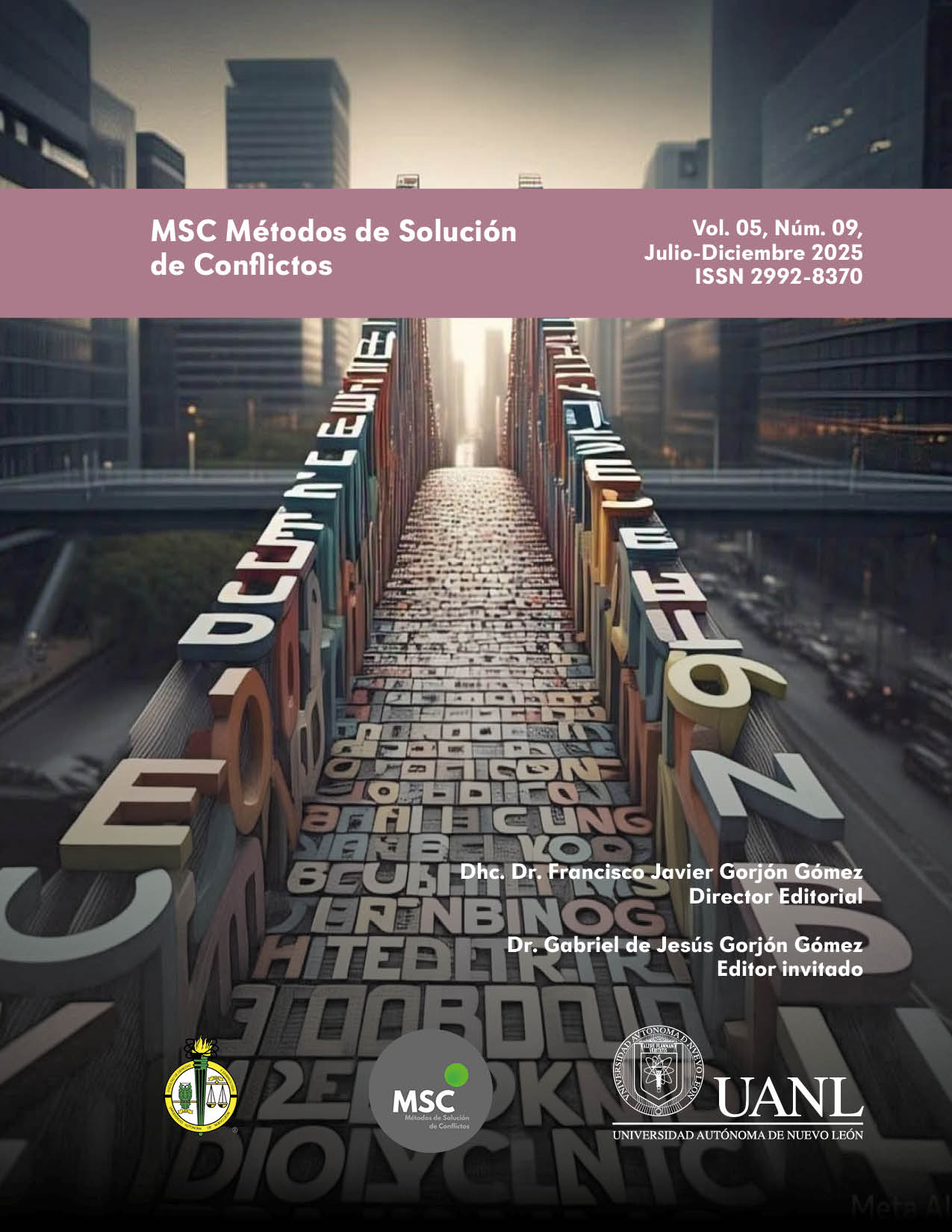Between Changes and Emotions
The Role of Subjective Well-being in Adolescence as a Tool for Building a Culture of Peace and Conflict Resolution
DOI:
https://doi.org/10.29105/msc5.9-124Keywords:
Subjective Well-being, Adolescence, Emotional Development, Conflict Resolution, Culture of PeaceAbstract
This article delves into adolescence, a pivotal transitional phase marked by profound physical, psychological, and social changes. Through a theoretical analysis, it focuses on subjective well-being, highlighting how adolescents perceive and evaluate their lives, emphasizing aspects of personal satisfaction and emotional balance. This well-being, understood as the positive perception and evaluation a person has of their life, can play a significant role in the development of skills for peaceful conflict resolution.
During adolescence, young people seek belonging, recognition, and a sense of purpose. When these elements are absent or threatened, interpersonal tensions and conflicts may arise and, without adequate resources, can escalate unnecessarily. Strengthening subjective well-being equips adolescents with greater emotional regulation, critical thinking, and empathy—key skills for facing social challenges constructively. In this regard, the article proposes that subjective well-being serve as a foundation for promoting the use of Alternative Dispute Resolution Methods (ADR) in school and community settings, contributing to a culture of peace. The article calls on educators, health professionals, and decision-makers to create environments that foster these competencies and ensure comprehensive support during this vital stage of human development.
Downloads
References
Arnett, J.J. (2007a). Socialización en la edad adulta emergente: de la familia al mundo más amplio, de la socialización a la autosocialización En J. Grusec & P. Hastings (Eds.), Manual de socialización (págs. 208 - 231). Nueva York: Guilford.
Albuquerque, I., de Lima, M. P., Figueiredo, C. y Matos, M. (2012). Subjective well-being structure: Confirmatory factor analysis in a teachers’ Portuguese sample. Social Indicators Research, 105, 569-580. http://dx.doi.org/10.1007/s11205-011-9789-6
Bradburn, N. M. (1969). The structure of psychological well-being. Chicago: Aldine.
Casas, F. (2011). Subjective social indicators and child and adolescent well-being. Child Indicators Research, 4(4), 555-575. http://dx.doi.org/10.1007/s12187-010-9093-z
Campbell, A., Converse, P. E., y Rodgers, W. L. (1976). The quality of american
life. New York: Russell Sage Foundation.
Casas, F. (2011). Indicadores sociales subjetivos y bienestar infantil y adolescente. Investigación de indicadores infantiles, 4, 555-575.
Conley, C. S., Travers, L. V, & Bryant, F. B. (2013). Promoting psychosocial adjustment and stress management in first-year college students: The benefits of engagement in a psychosocial wellness seminar. Journal of American College Health, 61(2), 75–86. DOI.org/10.1080/07448481.2012.754757
Cuadra, H., & Florenzano, R. (2003). El bienestar subjetivo: hacia una psicología positiva. Revista de psicología, 12(1), ág-83.
Csikszentmihalyi, M. (2005). Fluir (Flow). Una psicología de la felicidad. (1era edición 1990). (Undécima edición 2005). Barcelona: Kairós. {Versión original en inglés: Flow. The Psychology of Optimal Experience, 1990}.
Csikszentmihalyi, M. (1998). Aprender a fluir. (1era y 2da edición) Barcelona: Kairós. {Versión original en inglés: Finding Flow, 1997}.
Csikszentmihalyi, M. (1990). Flujo: la psicología de la experiencia óptima. Nueva York: Harper and Row.
Diener, E., Suh, EM, Lucas, RE y Smith, HL (1999). Bienestar subjetivo: tres décadas de progreso. Boletín psicológico, 125 (2), 276.
Diener, E. (1994). Assesing subjective well-being: Progress and opportunities. Social Indicators Research, 31, 103-157.
Diener, E., Lucas, R. E., & Oishi, S. (2018). Advances and open questions in the science of subjective well-being. Collabra: Psychology, 4(1), 1-78. doi:10.1525/collabra.115.
Diener, E., & Ryan, K. (2009). Subjective well-being: A general overview. South African journal of psychology, 39(4), 391-406.
Furnham, A., & Cheng, H. (2000). Perceived parental behaviour, self-esteem and happiness. Social psychiatry and psychiatric epidemiology, 35, 463-470.
Frederickson, B. (2009). Positividad: una investigación innovadora revela cómo aprovechar la fuerza oculta de las emociones positivas, superar la negatividad y prosperar. Editores de la corona/Casa aleatoria.
Fredrickson, B. L., & Losada, M. F. (2005). Positive affect and the complex dynamics of human flourishing. American psychologist, 60(7), 678.
Garaigordobil M, Pérez JI y Mozaz M (2008). Self-concept, self-esteem and psychopathological symptoms. Psicothema, 20, 114-123.
Hills, P., & Argyle, M. (2002). The Oxford Happiness Questionnaire: A compact scale for the measurement of psychological well-being. Personality and Individual Differences, 33, 1073-1082.
Mann, M., Hosman, C. M., Schaalma, H. P., & De Vries, N. K. (2004). Self-esteem in a broad-spectrum approach for mental health promotion. Health education research, 19(4), 357-372.
Mruk, CJ (2006). Investigación, teoría y práctica de la autoestima: Hacia una psicología positiva de la autoestima. Editorial Springer.
Margot, J.-P. (2007). La felicidad. Praxis Filosófica, (25), 55-79. Recuperado de http://www.scielo.org.co/pdf/pafi/n25/n25a04.pdf
Lyubomirsky, S. (2008). La ciencia de la felicidad. México, DF: Urano.
Leary, MR y Baumeister, RF (1995). La necesidad de pertenecer. Boletín Psicológico, 117 (3), 497-529.
Pavot, W. y Diener, E. (2013). Felicidad experimentada: La ciencia del bienestar subjetivo. En SA David, I. Boniwell y A. Conley Ayers (Eds.), El manual de felicidad de Oxford (págs. 134–151). Prensa de la Universidad de Oxford.
Pérez, L. T., Fuentes, N. I. G. A. L., Medina, J. L. V., Escobar, S. G., & Van Barneveld, H. O. (2012). Validación de la Escala de Felicidad de Alarcón para adolescentes mexicanos. Psicología Iberoamericana, 20(1), 71-79.
Rodríguez-Fernández, A. y Goñi, A. (2011). La Estructura tridimensional del bienestar subjetivo. Anales de Psicología, 27, 327-332.
Ryff, C., Keyes, C. (1995). The structure of psychological well- being revisted. wellbeing. Journal of Personality and Social Psychology, 69 (4), 719-727.
Rojas Monedero, Rosaura (2019). La educación para la paz y su influencia en el déficit de habilidades socioemocionales de los preadolescentes en Santiago de Cali, Colombia y Monterrey, México. Doctorado thesis, Universidad Autónoma de Nuevo León.
Ryan, R. y Deci, EL (2000). La Teoría de la Autodeterminación y la Facilitación de la Motivación Intrínseca, el Desarrollo Social, y el Bienestar. Psicólogo estadounidense, 55 (1), 68-78.
Seligman, M. (2011). La Auténtica Felicidad. Barcelona, España, Ediciones ZETA.
Scott, ES y Steinberg, L. (2008). El desarrollo de los adolescentes y la regulación de la delincuencia juvenil. El futuro de los niños, 15-33.
Shavelson, R. J., Hubner, J. J., & Stanton, G. C. (1976). Self-concept: Validation of construct interpretations. Review of educational research, 46(3), 407-441.
Steinberg, C. (2014). Abandono escolar en las escuelas secundarias urbanas de Argentina: nuevos indicadores para el planeamiento de políticas de inclusión educativa. Archivos de Análisis de Políticas Educativas/Archivos Analíticos de Políticas Educativas, 22, 1-26.
Downloads
Published
How to Cite
Issue
Section
License
Copyright (c) 2025 Lucia Todd

This work is licensed under a Creative Commons Attribution-NonCommercial 4.0 International License.
Los autores/as que publiquen en esta revista aceptan las siguientes condiciones:
a. Los autores/as conservarán sus derechos de autor y garantizarán a la revista el derecho de primera publicación de su obra, el cual estará simultáneamente sujeto a la Licencia Creative Commons Atribución-NoComercial 4.0 Internacional. que permite a terceros compartir la obra siempre que se indique su autor y su primera publicación esta revista.
b. Los autores/as pueden realizar otros acuerdos contractuales independientes y adicionales para la distribución no exclusiva de la versión del artículo publicado en esta revista (p. ej., incluirlo en un repositorio institucional o publicarlo en un libro) siempre que indiquen claramente que el trabajo se publicó por primera vez en MSC Métodos de Solución de Conflictos.
c. Se permite y recomienda a los autores/as a publicar su trabajo en Internet (por ejemplo en páginas institucionales o personales) posterior al proceso de revisión y publicación, ya que puede conducir a intercambios productivos y a una mayor y más rápida difusión del trabajo publicado (Véase El efecto del acceso abierto).







 MSC Métodos de Solución de Conflictos Vol. 5 Núm. 9, Julio-Diciembre 2025, es una publicación semestral editada por la Universidad Autónoma de Nuevo León, a través de la Facultad de Derecho y Criminología. Dirección de la publicación: Av. Universidad s/n Cd. Universitaria C.P. 66455, San Nicolás de los Garza, Nuevo León, México. revistamsc.uanl.mx, revistamsc@uanl.mx. Editor responsable: Dr. Francisco Javier Gorjón Gómez. Reserva de Derechos al Uso Exclusivo núm. 04-2023-110310161600-102 ISSN 2992-8370, ambos otorgados por el Instituto Nacional del Derecho de Autor. Responsable de la última actualización: Dr. Paris Alejandro Cabello Tijerina, Facultad de Derecho y Criminología Av. Universidad s/n Cd. Universitaria C.P. 66451, San Nicolás de los Garza, Nuevo León, México. Fecha de la última modificación: 28 de julio de 2025.
MSC Métodos de Solución de Conflictos Vol. 5 Núm. 9, Julio-Diciembre 2025, es una publicación semestral editada por la Universidad Autónoma de Nuevo León, a través de la Facultad de Derecho y Criminología. Dirección de la publicación: Av. Universidad s/n Cd. Universitaria C.P. 66455, San Nicolás de los Garza, Nuevo León, México. revistamsc.uanl.mx, revistamsc@uanl.mx. Editor responsable: Dr. Francisco Javier Gorjón Gómez. Reserva de Derechos al Uso Exclusivo núm. 04-2023-110310161600-102 ISSN 2992-8370, ambos otorgados por el Instituto Nacional del Derecho de Autor. Responsable de la última actualización: Dr. Paris Alejandro Cabello Tijerina, Facultad de Derecho y Criminología Av. Universidad s/n Cd. Universitaria C.P. 66451, San Nicolás de los Garza, Nuevo León, México. Fecha de la última modificación: 28 de julio de 2025.